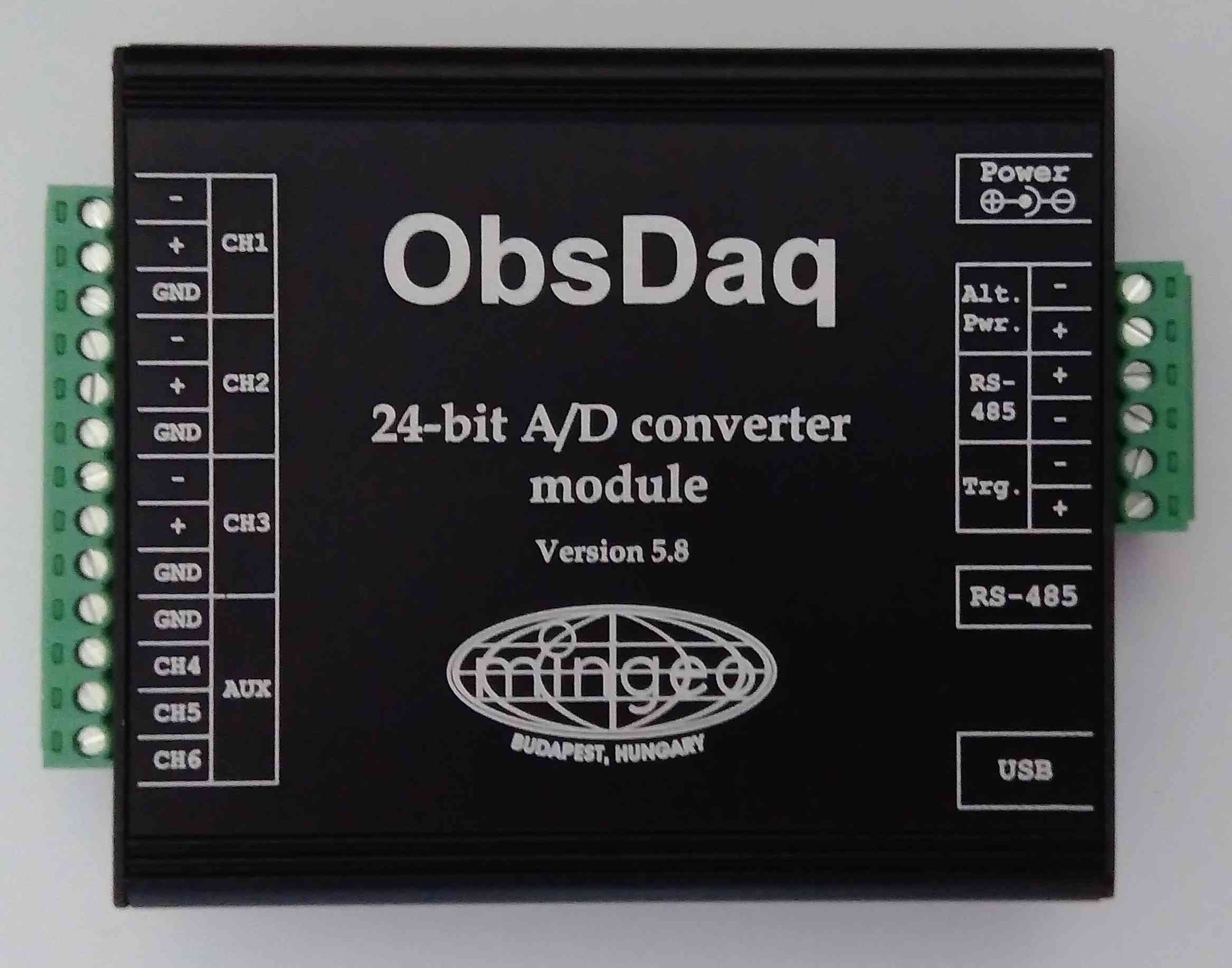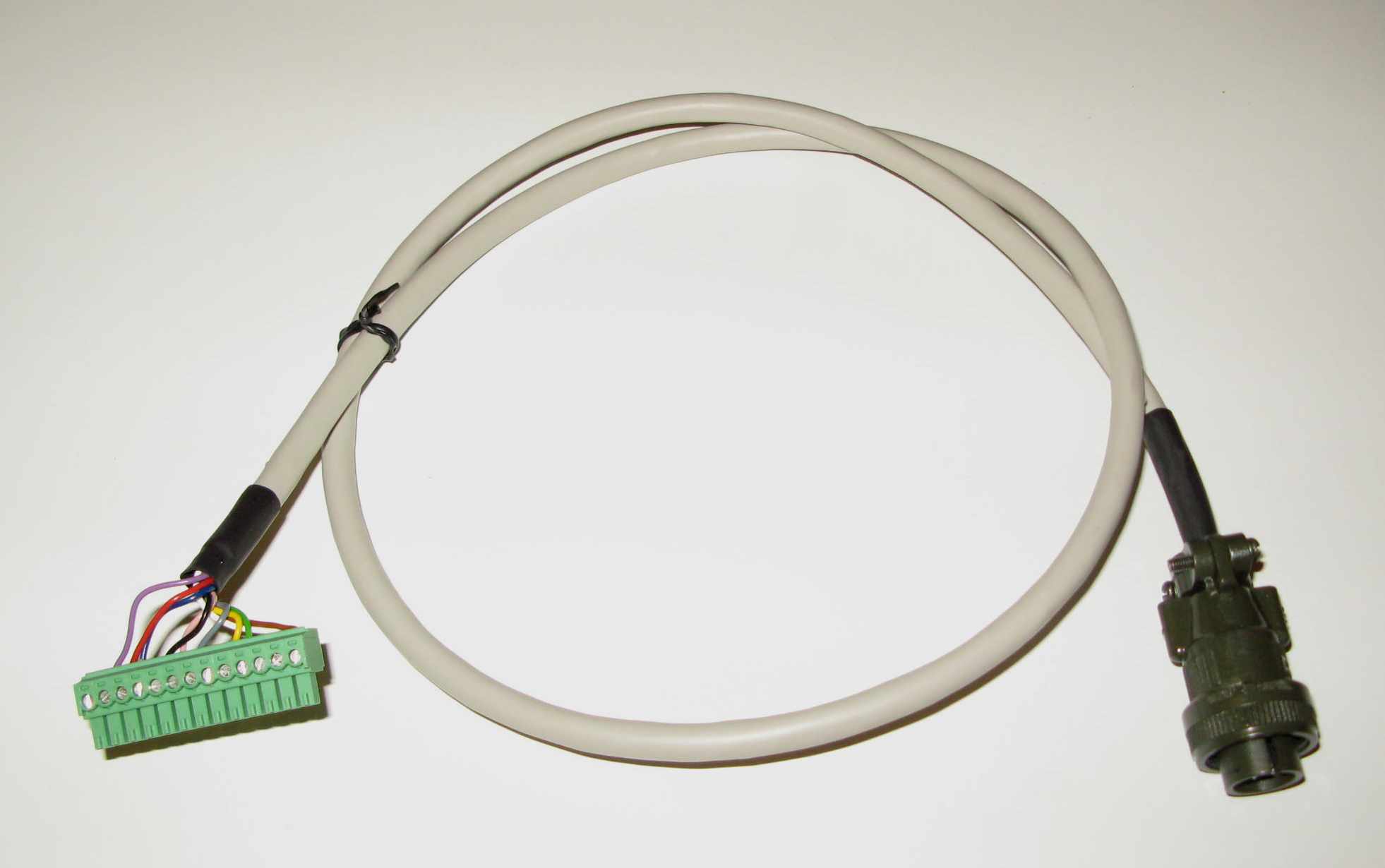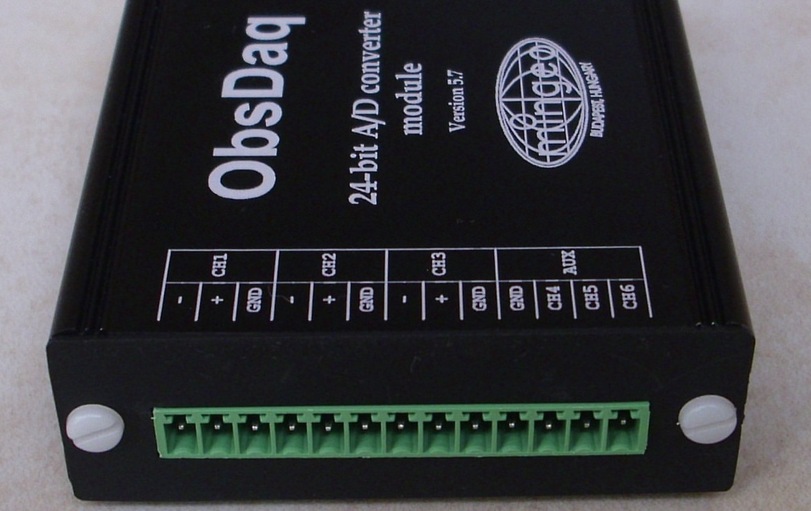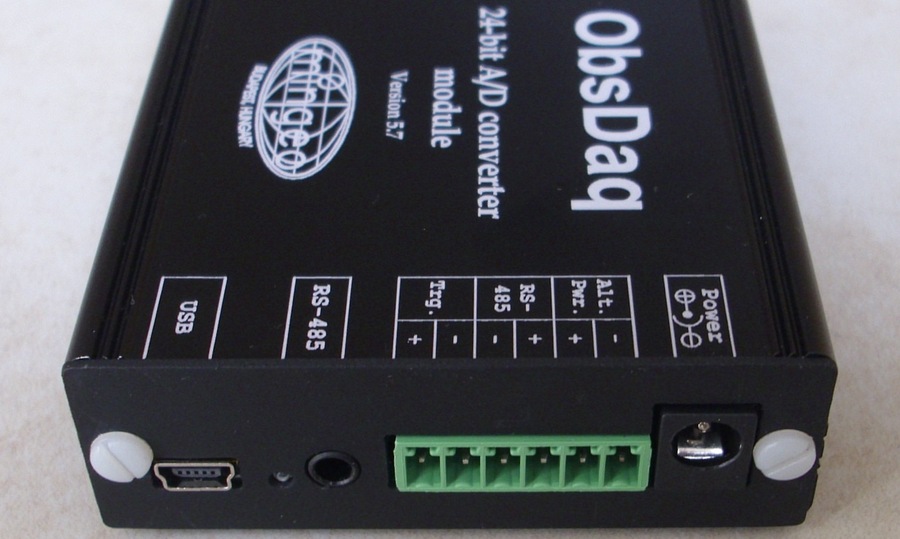24-bit fast A/D converter module for analog output magnetometers

ObsDaq is small size A/D module for simultaneous sampling of three analog channels of magnetometers and some other instruments. It features sampling rates up to 1280 Hz with high effective resolution and fast settling, programmable gains, free-run and triggered sampling modes. ObsDaq has additional analog inputs for auxiliary measurements, for example to record temperature sensors.
Three simultaneously sampling 24-bit A/D input channels for magnetometers analog output signals:
- High frequency, very low noise 24-bit delta-sigma converters
- Input ranges: ±10V and ±5V and ±2.5V using programmable gains on each channel (special hardware setups optimized for lower ranges are also available)
- Internal low-pass digital filter optimized for fast, one-sample settling
- Differential analog inputs, with the possibility to realize single ended measurements
- Three sampling modes: free-run (continuous), triggered and
one-record-per-request
mode:- In free-run mode, A/D conversions and the built-in digital filter run continuously, and the digital filter produces filtered data at a selected rate. The digital filter is not synchronized and the output rate is subject to the small error and offset of the internal clock of ObsDaq. Data from the digital filter are continuously sent to the output USB or RS-485 port. Selectable free-run sampling frequencies: 3.2, 6.4, 12.8, 32.0, 38.4, 64.0, 76.8, 128.0, 640.0 and 1280.0 Hz. Some other rates are also available by hardware modificaion.
- In triggered mode the built-in digital filter is directly triggered (started and stopped) by an internally generated higher frequency
trigger signal, that can be kept synchronized to an external, lower frequency (typically 1 Hz) trigger signal. External trigger
signal must be supplied by the user. For accurate timing, the external trigger signal has to be synchronized to an accurate clock:
1 Hz GPS-PPS signal is ideal for this purpose. (PalmAcq module and <Magrec-4C have such PPS signal output).
The frequency of the internal trigger can be programmed. Maximum possible triggered data output rate is about 500 Hz. Resulting timing accuracy is better than 0.1 ms. Triggered data are continuously sent to the output port.
A flag in the data stream identifies the records that were taken immediately after the external trigger events. This flag can be used for time stamp calculation in the host computer.
- In
one-record-per-request
mode, A/D conversion and the digital filter run in free-run mode or triggered mode, but records are not sent automatically to the output port. The host can read out the latest record by a sample request command. This mode can be used on lower frequency multichannel applications when more ObsDaq's are chained in one RS-485 network.
- No multiplexing, no interchannel-delay
- Input impedance: 170 kΩ
- Integral non-linearity is ±0.0015% of full-scale range
- Offset and full-scale calibration with internal reference or system calibration with external reference. Factory calibration data is stored in EEPROM.
Five supplementary A/D input channel:
- Three free 15-bit single ended analog input channels with 0...4.096 V input range and approx. 2 Hz sampling rate
- Internal temperature monitoring sensor
- Internal DC power supply voltage monitoring sensor
Non-volatile memory:
- 64 bytes non-volatile EEPROM memory to store serial-number and optionally hardware information, calibration constants and some other information
- Additional EEPROM memory to store up to 16 power-on automatic initialization and acquisition start commands
Power:
- Power requirement: 9...16 VDC, max.: 300 mA @ 12 V (required only to start), typical during operation: 95 mA @ 12 V
- Power input supports 1500 VAC isolation
- Special low power voltage supply mode (3.1 V) that allows operating ObsDaq directly from Li batteries (feature under test)
External trigger signal:
- Required only for high timing accuracy triggered mode
- 3.3V TTL/CMOS level signal
- Trigger input is opto-isolated
- Magrec-4C computer and PalmAcq module have compatible 1 Hz GPS-PPS trigger signal output.
Communication:
- RS-485 serial line and USB port, up to 307 200 baud rate.
- RS-485 port is isolated from the analog part and supports ±15 kV ESD protection
Communication protocoll:
- ASCII format commands and responses, ASCII and compact binary format data records
- Magrec-4C is prepared for data acquisition from ObsDaq
- Power on configuration data (sampling rate, gain, calibration constants, etc) can be programmed into EEPROM
Layout, connectors:
- Aluminium case: 82 x 70 x 24 mm
- DC power input: socket for 5.5 × 2.1 × 9.5 mm male cylindrical DC power plug
- 24-bit and 15-bit analog input channels: 13-pin pluggable terminal block
- Digital side: 6-pin pluggable terminal block for RS-485, alternative power inout and trigger inputs
- 3.5 mm TRS ("stereo jack") socket for a parallel/alternative RS-485 connection
- mini USB (mini-B) socket
- Indicator LED to signal power-on state and trigger events
Deafult accessories:
- DC power cable
- 13-way pluggable terminal block for the analog connection
- 6-way pluggable terminal block for digital connection and aux. power
- Manual in PDF format
Optinal accessories:
-
Analog cable (1 meter) to connect to FGE magnetometer's single ended 6-pin analog output connector

- Analog cable (1 meter) to connect to FGE magnetometer's DiffOut board 12-pin analog output connector
- Power cable to FGE magnetometer's 12 V power output (note: not all FGE electronics has power output)



